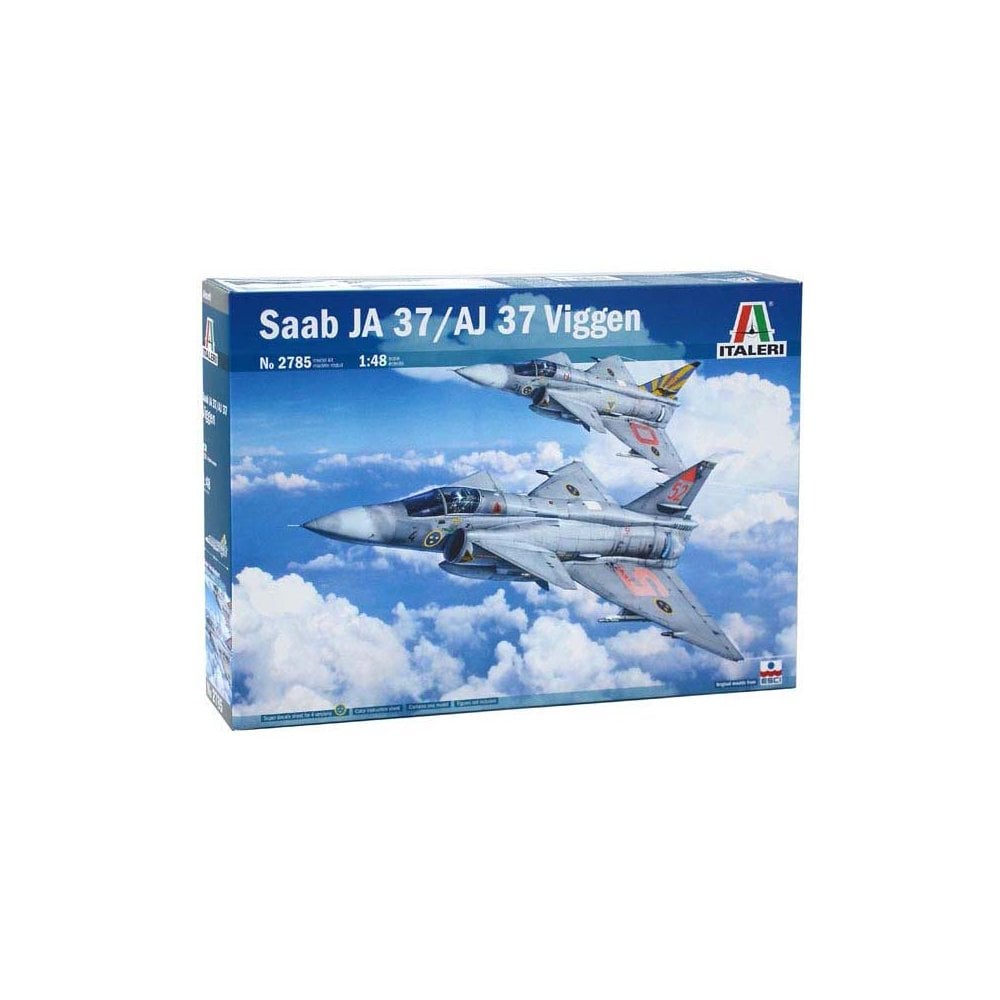ORIGINAL MOULDS FROM ESCI – COLOR INSTRUCTION SHEET – SUPER DECALS SHEET FOR 4 VERSIONSThe Saab Viggen fighter has been, for years, the backbone of the Swedish Air Force. The first AJ 37 Viggen has been developed to be a multi-role combat aircraft able to perform air defence, anti-ships and ground attack missions. Later on, in order to increase the effectiveness in the Swedish air defence system, the JA-37 “Jaktviggen” version was developed. It has been equipped with a new set of avionics, radar and weapon system able to enhance its role of all-weather fighter-interceptor aircraft. In terms of design the Viggen was characterized by the adoption of the delta-canard aerodynamic solution and it was powered by the big and powerful Volvo RM8 after burning turbofan. Thanks to it the Viggen was able to reach the max speed of Mach 2,1. The Saab Viggen has been progressively replaced by the new and technologically advanced Saab JAS 39 Gripen.The AJ 37 attack variant of the Viggen, where “AJ” stands for “Attack Jakt / Strike Fighter”, was the first of the series to go into service, and makes a useful baseline for further discussion.The AJ 37 had a spikelike fuselage, with:Fixed oval-shaped engine inlets alongside the canopy, with the inlets set off from the fuselage to avoid ingesting stagnant “boundary layer” air.A large rear-mounted delta wing.Canards alongside the engine inlets.A tall tailfin.Overall construction was of aircraft aluminium honeycomb, with titanium where required, such as engine firewalls. The Viggen was arguably less elegant in appearance than its predecessor, the SAAB 35 Draken, or its successor, the SAAB 39 Gripen, but it had a certain solid, businesslike, and combative style of its own. However, the extensive use of aluminium honeycomb made it surprisingly light for its size.The wing had a somewhat complicated form, designed as a double delta with something of a “hoop skirt” appearance in planform, and a dogtooth on each outer span. The dogtooth was added to improve longitudinal stability when carrying external stores. Each dogtooth was further marked by a bullet fairing for a radar warning receiver (RWR) antenna. There were two-section hydraulically actuated elevons on the trailing edge of each wing.The canards directed turbulent airflow over the main wing at low speeds, lowering the stall speed on landings. They had no dihedral and were fixed at a few degrees of incidence, but had trailing-edge flaps to improve takeoff performance. The canards on the first prototype had a noticeable dihedral as the aircraft was initially rolled out, but the dihedral was eliminated before the machine took to the air. The tailfin was fixed, with a one-piece rudder. The tailfin folded to the left to allow the aircraft to be stowed in hardened shelters at field bases. There was a fixed ventral fin under the tail.The AJ 37 featured tricycle landing gear, all gear featuring two wheels. The nose gear retracted forward. Each main gear assembly unusually featured its two wheels in tandem to reduce its depth for storage in the wing, and retracted inward from the wing towards the fuselage, with the main gear struts telescoping during retraction for a tighter fit. The landing gear was heavily shock-absorbed to permit steep “smackdowns” for short landings. Landings were said to be “firm” and apparently were much along the lines of carrier landings, except that the landing strip wasn’t moving.The RM8A afterburning turbofan was actually at the core a Pratt & Whitney JT8D-22 commercial turbofan, used on the Boeing 727 and Douglas DC-9 airliners, built under license by Svenska Flygmotor (later Volvo Flygmotor) and fitted with a Swedish-designed afterburner with thrust reverser. It was said to be the first production engine to ever have such a combination of features. The engine provided 115.7 kN (11,800 kgp / 26,015 lbf) afterburning thrust. The thrust reverser featured three “jaws” that snapped shut when the nose gear touched down, blasting the exhaust forward through three slots around the fuselage under the tail.It is unclear how the engine was started; cutaways of the machine do not show anything resembling an auxiliary power unit. The Viggen did have a ram-air turbine for emergency flight power, fitted to a door under the trailing edge of the left canard. The RAT popped out when hydraulic power was lost and (for some puzzling reason) when the landing gear was extended. There was a fuel tank in each wing, a saddle tank over the engine, a tank on each side of the engine, and a tank behind the cockpit, for a total of six tanks. There was no provision for inflight refueling, since that would have implied a “force projection” capability not in line with Sweden’s defensive posture.The pilot sat under a rear-opening clamshell canopy behind a one-piece windshield hardened against birdstrikes. There was a prominent humped dorsal spine running back from the canopy; most of the prototypes had a less prominent straight spine, but the enlarged spine improved transonic handling and was adopted for production.
£34.99 Original price was: £34.99.£31.49Current price is: £31.49.
1/48 SAAB JA 37/AJ 37 Viggen 2785 Italeri
In stock
| Weight | 0.4 kg |
|---|
- Royal Mail Standard* (2-3 Working Days)
- Royal Mail Express* (1-2 Working Days)
- FedEx* (Next Working Day)
- Free (2-6 Working Days)
** Limited to maximum weight of 2kg
* These are not guaranteed delivery times and delays are possible
Free delivery is subject to restrictions, orders between £60-£99.99 containing products that can only shipped with Royal Mail. Orders that include products like aerosols, large quantity of flammable products or over maximum size and weight allowed by Royal Mail will not be sent free and are subject to a carriage charge, Orders over £100 are not subject to restrictions and apply to UK Mainland only. Orders containing hazardous or oversized goods cannot be shipped to NI, IOM, IOW, Highlands, these are excluded from our free shipping.
Order cutoff times - Monday 11am, Tuesday to Friday 12pm.
Order processing days Monday-Friday
Working days are Monday to Friday and do not include weekends


